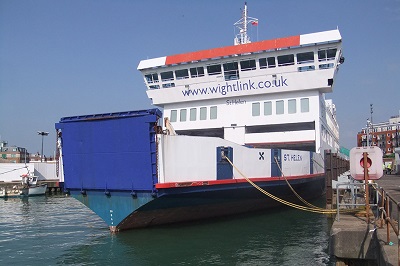Wire Rope Parted After Years of Neglect and Daily Inspections
The U.K. Marine Accident Investigation Branch (MAIB) has released its report into the collapse of a mezzanine deck on board the roll-on roll-off passenger ferry St Helen citing a long-standing maintenance failure by shipowner Wightlink.
The accident occurred at Fishbourne Ferry Terminal on the Isle of Wight in July 2014. The passengers and vehicles on board the 77-meter (250-foot) cross-Solent roll-on roll-off passenger ferry were in the process of disembarking at Fishbourne ferry terminal on the Isle of Wight when the vessel’s starboard forward mezzanine deck collapsed.
The collapse occurred because one of the deck’s steel wire lifting ropes parted as it and the deck had not been routinely lubricated.
The parting wire caused the forward inboard corner of the suspended deck to drop from a height of about two meters (six feet) and hit the main deck below.
 A crewman and 11 cars, with their seated passengers, were on the deck at the time. The crewman suffered a minor head injury and was temporarily rendered unconscious; several passengers suffered minor impact related injuries.
A crewman and 11 cars, with their seated passengers, were on the deck at the time. The crewman suffered a minor head injury and was temporarily rendered unconscious; several passengers suffered minor impact related injuries.
The force of the impact caused the failure of one of the mezzanine deck’s main structural beams. Post-accident analysis of the failed wire rope found that it had suffered a significant amount of mechanical wear. The mechanical wear, which had primarily been attributed to internal and external abrasion caused by a lack of lubrication, had severely diminished the strength of the rope.
The investigation found weaknesses in the way that Wightlink had managed the day-to-day maintenance of its vessels and, in particular, their mezzanine decks. This was despite the mezzanine decks being subject to regular inspections and mandatory six-monthly thorough examinations by a Royal & Sun Alliance Engineering Inspection & Consultancy surveyor.
A Long-Standing Issue
The investigators found that Wightlink was aware of many of the safety issues and contributing factors highlighted in this investigation report. Of note: the absence of a formal mezzanine deck greasing routine had been subject to an internal safety management system non-conformity for over two years. The failure to address the non-conformity was highlighted by the Maritime and Coastguard Agency nine months prior to the accident, and the failure to lubricate the steel wire lifting ropes was identified during six-monthly examinations.
Given this knowledge, and the potential consequences of a rope parting, Wightlink demonstrated little or no appetite to allocate the resources necessary to resolve this long-standing issue. This apparent lack of impetus was probably influenced by an over reliance on its four-yearly wire rope replacement program and the Royal & Sun Alliance Engineering Inspection & Consultancy and the Maritime and Coastguard Agency’s reluctance to escalate the issue.
Daily Inspections
Daily and monthly inspections were conducted by the ship’s crew and recorded in various logbooks and checklists. After an overnight or longer layover period, a member of the deck crew inspected the mezzanine decks prior to loading vehicles for the first crossing of the day. This included a visual inspection of the lifting ropes. The inspections were recorded on a daily inspection log sheet. Additionally, any faults or other problems that were identified during the crossings were recorded within the vessel’s bridge day book.
At the end of every shift the master completed an operational status form listing the status of all critical and important equipment. The mezzanine decks were classified as ‘Important’ equipment. The last status report recorded on the day of the collapse gave the starboard forward mezzanine deck an operational status of “A.”
 Manufacturer’s Inspection
Manufacturer’s Inspection
At Wightlink’s request, the original equipment manufacturer, MacGregor, conducted detailed inspections of all the mezzanine decks, and other MacGregor equipment fitted on board its conventional ferries.
MacGregor’s inspections identified a range of issues that supported the findings in a separate The Test House (Cambridge) Ltd analysis of the wire rope. In particular, the manufacturer’s reports highlighted that the lifting ropes had not been protected against corrosion, several lifting ropes were found to be damaged, and many of the rope sheaves were corroded and had visible imprints of the steel wires in their grooves. The MacGregor inspections also found examples of:
• Incorrect adjustment of lifting ropes.
• Slack wire rope adjusting mechanisms.
• Ropes fouling the edges of the deck beam lightning holes.
• Hydraulic pipe corrosion.
• Hydraulic oil leaks from various components.
The inspections of the MacGregor bow and stern doors found:
• A lack of lubrication on the door assemblies.
• Wear on bow and stern door locking mechanisms.
• Inoperative warning sirens.
• Damaged guide rails.
The MAIB investigation report is available here.
